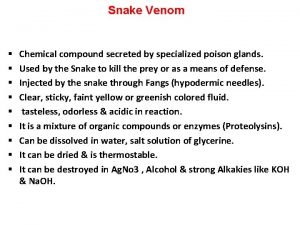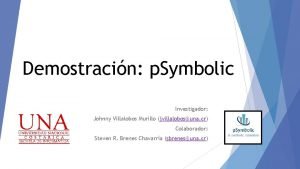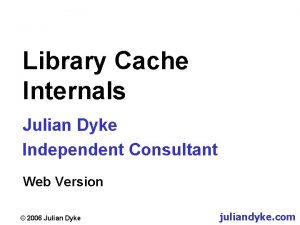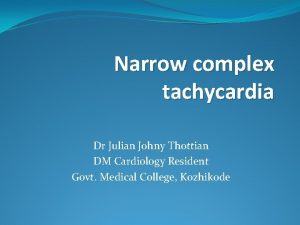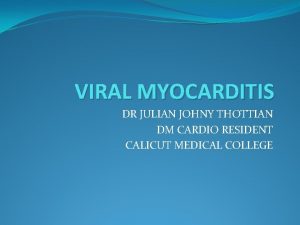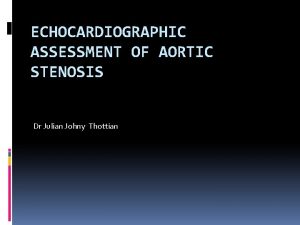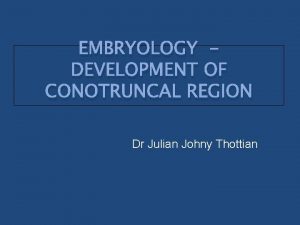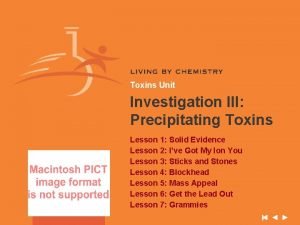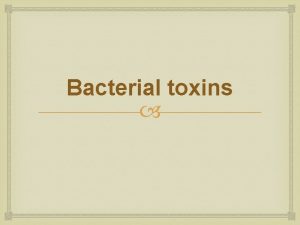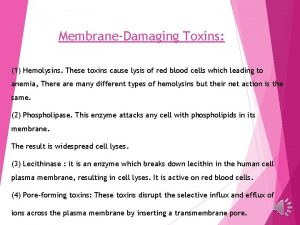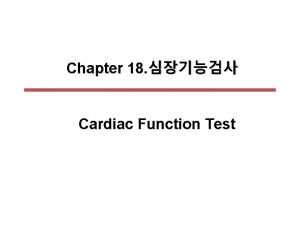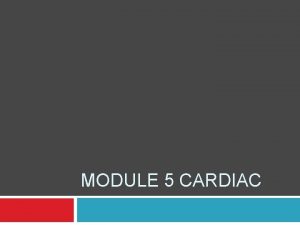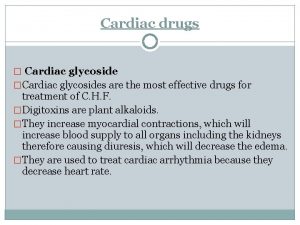Cardiac toxins Plants Dr Julian Johny Thottian Case






















- Slides: 22

Cardiac toxins- Plants Dr Julian Johny Thottian

Case • 18 yr old unmarried pregnant Tamilian female brought to the casualty with giddiness and vomiting • PR – 38/mt irregular BP – 90/60 mm. Hg • No focal deficits • Toxic look • CVS- S 1 varying S 2 with normal split • Chest – NVBS • Alleged consumption of Nerium Seeds from work site

Investigations Hb -11. 2 gm%, TC-11220/cm 3 , PLT – 220000/cm 3 ESR- 16 mm/1 st hr DAY Na( meq/l) K(meq/l) Bld Urea S creat 1 142 4. 1 18 0. 6 2 136 3. 6 22 0. 6 3 138 3. 9 19 0. 8 4 140 4. 5 29 0. 6 5 136 4. 5 26 0. 9 6 138 4. 2 26 0. 8

ECG before pacing – 24 hrs after consumption

Paced

Day 7 - when pacing was removed

Patient stay in hospital was uneventful and treated with orciprenaline , electrolyte correction & antibiotic. Patient removed from temporary pacing • Discharged on the 8 th day.

Cardiac Glycosides

Nerium- white oleander (kaner)

• Dogbane family • Ornamental shrub with white & pink flowers • All parts are poisonous including the smoke while burning • Used as an abortifacient, homicide and suicide • Fatal dose – 15 -20 gms of root • Fatal period – 24 to 36 hrs

Cerebra thevetia- yellow oleander ( pila kaner)

• Fatal dose : 8 -10 seeds, 15 -20 gms of root, 5 -10 leaves • Fatal period 2 -3 hrs

Cerebera odallam (pili kirbir)

• Fatal dose – kernel of one fruit • Fatal period -1 -2 days

Aconite (mitha zeher- monk`s hood) • All parts are poisonous especially the root • Clinical features- nausea , vomiting , profuse sweating • Hippus • Hypotension, AV BLOCK • Fatal dose – 1 gm of root • Fatal period – 1 -8 hrs • Treatment –Gastric lavage , atropine

Cleistanthus collinus (oduvan) • • • Closely related- it is a glucoside Blocks cardiac conductive system Conduction defects Fatal dose – 200 -400 gms of leaves Fatal period – 1 -3 days

POPULARITY AS A POISON • In Sri Lanka, cases of attempted suicide with yellow oleander were extremely rare before 1980. During that year, the deaths of two girls who intentionally ate yellow oleander seeds was widely reported in local newspapers. The practice suddenly became so popular that the number of cases admitted to Jaffna hospital increased from zero in 1979 to 103 in 1983. QJM (1999) 92 (9): 483 -485. doi: 10. 1093/qjmed/92. 9. 483

Studies across the world • Dept of internal medicine, Colombo- a study on 300 patients -Ventricular ectopics and tachycardias are common in digoxin-poisoned patients, but are less common in oleander-poisoned patients • 53% had AV node conduction block, while 62% had sinus node block; 30% had conduction block affecting both nodes. Only 1% had ventricular tachycardias and 8% had ventricular ectopics • They report that most of the deaths are due to ventricular arrhythmia • Mortality is 20% in their study.

Electrocardiography Increased PR interval, T wave flattening or inversion Tachyarrhythmias Bradycardia & heart block – SA block and AV Block

Management • Induction of emesis & activated charcoal Adminis tering Atropine for severe bradycardia Using Phenytoin or Lidocaine hydrochloride to control arrhythmia. Placing a temporary venous pacemaker Electrical counter shock Digoxin-specific Fab antibody fragments (Digibind).

• Osterloh et al calculated the lethal oleander leaf dose of their patient to be approximately 4 gm.

THANK YOU
 Types of snake toxins
Types of snake toxins Unit 4: toxins lesson 78 worksheet answers
Unit 4: toxins lesson 78 worksheet answers Toxic reactions chemical equations answer key
Toxic reactions chemical equations answer key Human pathogens and toxins act
Human pathogens and toxins act Jonny villalobos
Jonny villalobos Johny sinfullife
Johny sinfullife Best case worst case average case
Best case worst case average case Vascular vs nonvascular plants
Vascular vs nonvascular plants Non vascular plants
Non vascular plants Non flowering plants characteristics
Non flowering plants characteristics C3 plant
C3 plant Julian beever meeting mr frog
Julian beever meeting mr frog Julian erdmann
Julian erdmann Julian vs swift
Julian vs swift Julian beever
Julian beever Julian opie portraits
Julian opie portraits Julian aristides gonzalez
Julian aristides gonzalez Expiration date julian code
Expiration date julian code Julian dyke
Julian dyke Percy l julian high school
Percy l julian high school Julian motamedi
Julian motamedi Honor in beowulf
Honor in beowulf Two types of years
Two types of years
